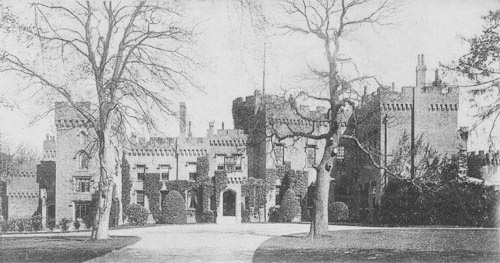Lea Castle
Worcestershire
| Location | Wolverley | ||
| Year demolished | 1945 | ||
| Reason | Derelict | ||
| See all images: | Gallery | ||
| << Back to the main list |
The fine park and a campsite at Wolverly are all that mark the passing of the imposing mock castle which once dominated the estate.
 Lea Castle was built with the profits of the local iron industry. The Cookley Ironworks were founded in the late 1600s and the town quickly became the centre of the local iron and tinplate industry - not least because a local resident, one Joseph Piper, invented and then patented a successful tinning process. The mill at Cookley was originally a corn mill but by 1706 it, and another local mill, had been taken over by the new industry. These two mills were leased by the Knight family and by 1750 they had purchased them outright.
Lea Castle was built with the profits of the local iron industry. The Cookley Ironworks were founded in the late 1600s and the town quickly became the centre of the local iron and tinplate industry - not least because a local resident, one Joseph Piper, invented and then patented a successful tinning process. The mill at Cookley was originally a corn mill but by 1706 it, and another local mill, had been taken over by the new industry. These two mills were leased by the Knight family and by 1750 they had purchased them outright.
Edward Knight owned the mills for thirty years until his death in 1780. It was Edward, with the wealth generated from the iron works, who had Lea Castle built in the then fashionable neo-Gothic style in 1762. Situated on an outcrop, the house was a large, brick-built castellated mansion which was described in 1848 as:
"...a noble mansion surrounded by 550 acres of land enriched with plantations of oak and other timber."
On Edward's death the house and business passed to his son, John Knight. However, in 1823, he sold the house to John Brown who is said to have greatly improved it. On his death the house passed to his daughter and then, by marriage, into the Westhead family. In 1848 it was owned by Joshua Proctor Brown-Westhead, a former local MP and chairman of the Inventors Society. In 1913 it was the residence of Mr. George Montagu Brown-Westhead, B.A., LL.M. Whatever the wealth was which had enabled the Brown family to purchase the house, it had evidently gone by the twentieth century. Maud Westhead-Brown inherited the estate aged just 16. She later married but by 1933 the decision had been taken to sell off the estate. The auction was held in the Lion Hotel in Kidderminster with many of the lots being sold to individuals.
Little further information exists about the house from this period. One can assume that as the estate was being sold there were financial issues and that the house was unlikely to have been well-cared for. In 1939 the local council investigated whether it would be suitable for housing refugees but already the house was in such a state of disrepair that the idea was abandoned. Lea Castle was eventually demolished in 1945. All that remains of the house is some parkland and the long boundary wall and imposing North Lodge gatehouse.